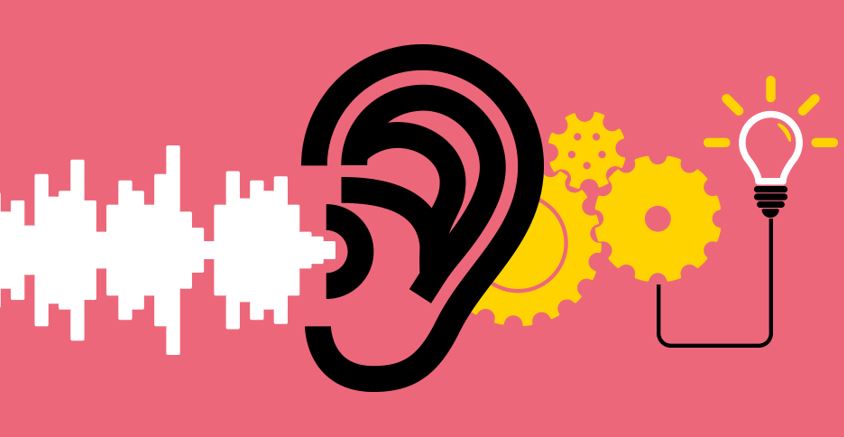The American Speech-Langauge-Hearing Association (ASHA) dedicates each May to Better Hearing and Speech month, during which time ASHA creates opportunities for education about communication disorders and the organization’s role in providing treatment. ASHA defines a communication disorder as an “impairment in the ability to receive, send, process, and comprehend concepts or verbal, nonverbal and graphic symbol systems” (American 1993). Whether or not you or someone you know lives with a communication disorder, it is a fact that all people communicate and experience communication challenges to varying degrees.
“Most people do not listen with the intent to understand; they listen with the intent to reply” (Covey, 2020).
An indispensable piece of communicating is listening. And it’s likely that much of the “listening” that happens in our lives is in service of keeping a conversation going, whether we are thinking about getting the next word in or simply about being heard ourselves.
How dependent we are upon giving patterned “appropriate responses,” especially if someone shares a particularly joyful or difficult moment. We might be so focused on saying the “right” thing in response to what we hear that we miss the person’s share altogether. Although well-crafted verbal responses and good conversation-flow have their place in the world, sometimes they can detract from more authentic relational practices. For instance, exchanges where people can be genuinely present to each other’s experience often do not follow linear patterns and do create a space where honesty and mutual trust can thrive. Let’s suspend reality for a moment and think what it might be like if our conversations were not so response-oriented and more oriented to actual listening.
So then, what does it mean to truly listen?
A great deal of our dependence on conversation-flow is centered in “knowing,” or thinking that we know. For instance, we assume we know what the conversation is about, what the other person is saying, and what will come next. Listening, however, requires a different sense—a sort of “not knowing.” The quality of “not knowing,” can best be described in terms of empathetic listening. A Mental Health First Aid article explains empathetic listening as “taking a moment to step out of our normal patterns of thinking and feeling to imagine what it feels like to be the person in front of us” (Hoffman, 2017).
In this way, the work listening is largely internal. This is not to say that in listening, we have to somehow delete or neglect our own experiences or knowledge. Rather, listening is about creating space in our personal awareness to house or hold another’s experience, if only just for a few moments. So the question is, what are we doing in our minds and bodies to actively create a momentary container for another person’s experience?
An article advising school leaders in empathetic listening describes a set of mindful practices that can be helpful, namely, those involving the action of noticing (Brown 2017). Instead of jumping into a position of assuming and knowing the answers, actions of mindful noticing help to clear the area for discovery and, therefore, better listening when exchanging with another person. For instance, the person who is listening can notice what it’s like to give someone their full attention without inserting comments. Then, when distraction strikes, the listener can notice what it’s like to become distracted and what it is like to come back to presence in the conversation.
Likewise, one can notice the internal feelings that arise when hearing another person‘s experience. Often the emotional reactions upon hearing certain words or reading another person’s body language are immediate and sometimes strong. Gently acknowledging the existence of these responses rather than berating oneself for having them or projecting them into the exchange can help a person return to a space of active listening.
There is never a wrong time to begin taking small steps to practice listening. What is your friend, co-worker, or the person next to you in the grocery store aisle saying? You might be surprised by what you discover, not only about the speakers but about yourself.
Click here to create your TPN.Health clinical profile and begin making connections in the trusted digital referral network. Stay tuned for virtual continuing education opportunities and live panel discussions featuring experts in the behavioral health field!
References:
American Speech-Language-Hearing Association. (1993). Definitions of communication disorders and variations [Relevant Paper]. Available from www.asha.org/policy.
Brown, V. (2017, March 8). 8 Ways School Leaders Can Practice Empathy in Listening. Retrieved from https://www.leadsmartcoaching.com/blog/8-ways-school-leaders-can-practice-empathy-listening/
Covey, S. R., & Collins, J. C. (2020). The 7 habits of highly effective people: powerful lessons in personal change. New York: Simon & Schuster.
Hoffman, Erica (2017, July 28) . The Quiet Power of Empathic Listening. Retrieved from https://www.mentalhealthfirstaid.org/2017/07/quiet-power-listening/
Image Credit: https://lingportal.com/blog/articles/how-to-improve-listening-ways-to-improve-your-english/
